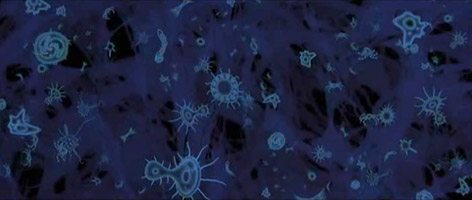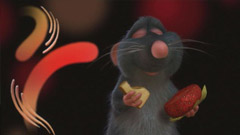In the early 2000s, American studios transitioned to from hand-drawn to cg animation—or they left feature animation altogether. Warner Bros. Feature Animation wound down with Osmosis Jones, a live action/hand-drawn hybrid. Michel Gagné had spent one-and-a-half years on the project, designing and supervising its effects, including the microbes in the opening title sequence. Alas, the film tanked. The artists had to seek employment elsewhere.
With the future uncertain in traditional animation, Michel had some options to consider: Would he continue to work on a project-to-project basis for Hollywood studios, or would it be better to focus on his own projects, and try to make a living working for himself?
He decided to go independent. And leave Los Angeles.
Michel and his wife Nancy moved to Bellingham, Washington. He would continue publishing his books, and his Zed comic books. Meanwhile, thanks to the Internet and his own industry connections, people started coming to him to illustrate or animate their projects. DC Comics wanted him to write and illustrate a Batman story in his own style. He called it: “Spore.” How did fans respond? “Pretty much everyone agreed on one thing,” Michel said, “This was probably the most insane Batman story ever published!”
In 2003, Genndy Tartakovsky recruited him to do special effects for Cartoon Network’s Star Wars: Clone Wars series. Michel’s stunning effects would be recycled for Season 2. Clone Wars won Emmy Awards for both seasons, in 2004 and 2005. Tragically, while the key creative team—including the sheet timer—was honored, Michel was not included.
In 2005, Michel pitched a series of spooky interstitials using silhouetted animation to various studios. Nickelodeon loved the idea and commisioned the films for their 2005 Halloween promotion, “Halloween Shriekin Weekend”. Insanely Twisted Shadow Puppets employed a new type of production, Flash animation.
Meanwhile, Michel continued his foray into visual abstracts with Sensology, inspired by a musical performance by piano maestro Paul Plimley. The music caused Michel to have “an intense synesthetic experience.” He listened to three of Plimley’s compositions from the album, “Sensology,” and illustrated its music. For Michel, this was “a true spiritual and artistic journey,” which he talks about here.
The production of Sensology lasted four years, during which Michel juggled his many other projects.
A nine-second Sensology teaser was posted online in the fall of 2006—and seen by his friend Brad Bird at Pixar, who was working on Ratatouille. Bird wanted Michel … to visualize taste, as dreamed by Remi and Emile. How could “taste,” an abstract sense, be designed and animated? Leave it to the Cosmic Mind to pull it off.
Finally, in July 2010, Michel completed his masterpiece of abstract expression. Experience Sensology for yourself:





















